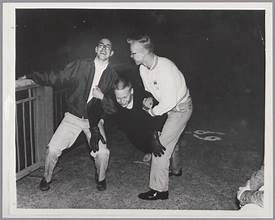The Curious Case of the Smoot: An Unconventional Unit of Measurement
- Stephanie Erickson
- Sep 4
- 3 min read
The Curious Case of the Smoot: An Unconventional Unit of Measurement
Have you ever heard of measuring something in "smoots"? Probably not, unless you're familiar with a quirky tradition at the Massachusetts Institute of Technology (MIT). I was watching the news Channel 5 out of Boston, which was reporting that the Smoot markings on the Harvard Bridge were being re-painted. I immediately thought "This is a great phenomenon for introducing measurement, precision, and accuracy", which my students are struggling in! The smoot, a nonstandard unit of length, originated from a fraternity prank in 1958 and has since become a part of MIT's unique culture.
The story begins in 1958 with Oliver R. Smoot, Jr., an MIT freshman and Lambda Chi Alpha fraternity pledge. As part of a pledge activity, Smoot was chosen to be the measuring stick for the Harvard Bridge, which connects Boston and Cambridge, Massachusetts. His task was simple: lie down repeatedly while his fraternity brothers marked his position.
Oliver Smoot's height at the time, five feet and seven inches (approximately 1.70 meters), became the official length of one "smoot". The fraternity brothers then proceeded to measure the entire bridge by having Smoot lie down, marking his head and feet, and then repeating the process. They marked the bridge every ten smoots with paint.


The final measurement of the Harvard Bridge came out to be 364.4 smoots, plus or minus one ear. The "plus or minus" was included to account for the uncertainty in the measurement. Imagine trying to lie perfectly still while being used as a measuring tool – it's not as easy as it sounds! Oliver Smoot himself admitted that he got tired of the exercise and eventually had to be carried between positions.
Despite the somewhat haphazard method, the "smoot" markings became a beloved feature of the Harvard Bridge. Every semester, new members of the Lambda Chi Alpha fraternity repaint the "smoot" markings, ensuring the tradition continues. These markings typically appear every 10 smoots, but you can also find marks at other intervals.
Even when the Massachusetts Department of Public Works decided to replace the concrete on the bridge in 1987, there was public support for preserving the "smoot" markings. The government body in charge of the bridge stated, "We recognize the smoots' role in local history... smoots aren't just any kind of graffiti. They're smoots!". Two "smooted" sections of sidewalk were even given to the MIT museum.
Oliver R. Smoot, Jr., the man behind the measurement, graduated from MIT in 1962 and went on to have a successful career. He became a lawyer and later served as chairman of the American National Standards Institute (ANSI) and president of the International Organization for Standardization (ISO). He even returned to MIT in 2008 for a 50th-anniversary celebration of the smoot, where a plaque was installed on the bridge in his honor.

The "smoot" has also made its way into the digital world. Google Maps has included the smoot as a unit of measurement in some of its calculations. It's a testament to the enduring appeal of this unconventional unit that started as a simple fraternity prank.
Student Activity
Have students create their own Smoot unit. It could be a body part, a whole person, or an object. The only caveat I give is that what they choose HAS to be unconventional; they can not use a measuring tape, meter stick, or other standardized measurement device. If it's a beautiful day out, get them outside and have them measure several locations around the school campus. I always choose one location that they all need to measure, which I measure using a measuring wheel. This allows you to have them complete a percent of error calculations and compare the various measurements within a class or classes. This also leads to discussions on sources of error in measurements, accuracy and precision. Download my lab for free on Teachers Pay Teachers.
After this activity, I have my honors class research other non-standard units and compare them to the metric system. We then read about the metric system and how it was signed into law in 1975 by Congress as the measurement system for the US, but Americans are stubborn and refused to change. Check out my podcast on the Metric System and Customary Units on Spotify, Apple Podcasts, and other podcast sources.






Comments